Natural Rythms: Winter
Small but clever, these little creatures have adapted to winter’s snows.
Among the mammals that winter-over in Tahoe, squirrels and chipmunks are perhaps the most numerous, and interesting, employing a variety of strategies to make it through the long, snowy season. Like all creatures that stick around through the harshest months of the year, squirrels either can stay active and try to find enough food to meet the high energetic demands of freezing temperatures and deep snow, or they can shut down and simply wait for warmer weather. Our diverse community of squirrels exhibits a full range of strategies across this spectrum.
Flying by Night
Tree squirrels tend to stay active, especially the large western gray squirrels that put on a bushy winter coat. The smaller Douglas’ squirrels are less insulated and more prone to sleeping through brief periods of particularly bad weather. Northern flying squirrels, which might lose their ability to glide if they put on weight through added fat or fur, do not hibernate at all. Rather, they huddle together in tree cavities or well-constructed nests to wait out storms, and forage for fungus during the coldest part of the day: the night. All flying squirrels are nocturnal, presumably due to daytime predator dangers, but this certainly makes their survival even more difficult during cold winter nights. Despite this penalty, most find enough food to make it through.
Staying on Schedule
Our four species of ground squirrels hibernate for the winter, a sensible strategy for animals that forage on ground that can be covered by tens of feet of snow for months at a time. Over millennia, this schedule can become hard-wired, such that actual snow on the ground has little to do with the timing of hibernation. In fact, female Belding’s ground squirrels start their hibernation in August to save energy, giving them one of the longest dormancies of any North American mammal—approximately eight months! Marmots pack on fat to survive their long hibernation, but the bounty of fresh greens, their favored food, occurs earlier in summer. Mid-summer obesity would make them easy targets for predators, so they wait until the end of the season, and then convert vegetation into body fat as fast as they possibly can.
“Little Bears”
The Tahoe region has no fewer than five species of chipmunk, all of whom larder caches of food to survive the winter. Through the winter, these animals sleep for brief periods (e.g. two weeks), and then wake just long enough to eat a snack and rid themselves of digestive wastes. During warmer periods, they may surface briefly for a little exercise and fresh air. Alternatively, they may surface for long periods. In fact, much like Tahoe’s bears, the amount of torpor our chipmunks exhibit can vary tremendously from year to year and from place to place. It all depends on how much food is available. If our chipmunks can find food through the winter, they will stay active and eat. If food is too hard to come by, they can save considerable energy by retiring to their cycles of hibernation. Regardless, the chipmunks will “squirrel away” as many seeds and berries as they can during the fall. These larders become especially important in March, when stores may be running low, and deep snows cover last year’s seed crop. The shadow chipmunk is somewhat unique in that it also puts on a layer of fat for the winter, and therefore does not have to wake nearly as often as the other species.
Category: Natural World, Winter







